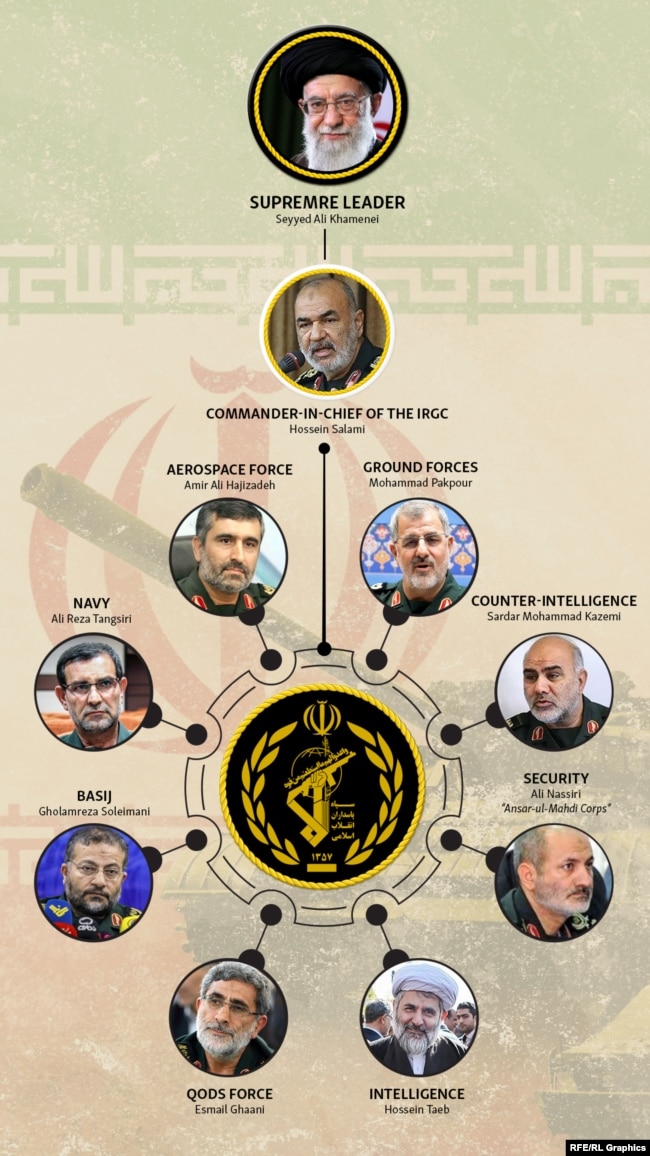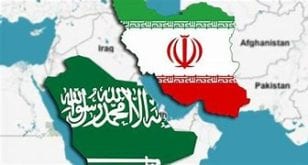Radiofarda – Immediately after General Qassem Soleimani was killed in a U.S. airstrike on January 3 local time, near Baghdad airport, the Islamic Republic Supreme Leader Ayatollah Ali Khamenei appointed the dead general’s deputy, Esmail Qa’ani (Ismail Ghaani), as his successor in charge of commanding Qods (Quds) Force.
By doing so, Khamenei was relaying a message that was also reflected in his directive appointing General Qa’ani. “The business in Qods Force goes on as usual, and as planned by the ‘martyr’ General Soleimani,” he insisted.
But who are Qa’ani and other commanders assigned to follow the footsteps of the fallen General? Do they have the caliber to fill the gap left by their ambitious former boss?
Radio Farda’s Morad Veisi has tried to answer these questions.
On paper, Qods Force is a subdivision of the Islamic Revolution Guards Corps (IRGC), along with Naval, Aerospace, Ground Forces, and Baseej (Mobilisation Resistance) Organization.
Nevertheless, in practice, the Chief Commander of the Qods Force is only and directly accountable to the Supreme Leader of the Islamic Republic.
Responsible for the Islamic Republic extraterritorial military operations, the Qods Force specializes in unconventional warfare and army intelligence.
Meanwhile, it supports non-state groups in many countries, including the Lebanese Hezbollah, Hamas, and Palestinian Islamic Jihad in the Gaza Strip and the West Bank, Yemeni Houthis, and Shia militias in Iraq, Syria, Bahrain, and Afghanistan.
Washington has designated most of these groups as terrorist organizations.
The Qods Force recently extended its presence in some African countries, as well. Its ambitious operations in African led to its addition to the U.S. list of international terrorist entities.
To orchestrate their foreign operations, the leaders of the Islamic Republic decided in 1988 to place all active groups outside Iran under a single military umbrella. That is how the Qods Force was born. An IRGC commander, Ahmad Vahidi, was appointed as the Chief Commander of the newly founded entity.
Vahidi, later a Defense Minister (2009-2013), was the only IRGC member present at the controversial secret talks between the Islamic Republic representatives and a U.S. delegation headed by the former White House Security Advisor, Robert Carl “Bud” McFarlane, in 1986.
However, the Qods Force remained in the shadows under the command of Vahidi (1988-1997).
The Ascendance of Soleimani
As soon as Qassem Soleimani replaced Vahidi in 1997, the Qods Force started to flourish and extend its influence in and outside Iran. As one of the Supreme Leader’s favorite IRGC commanders, Soleimani succeeded in establishing himself as a decisive figure across Iran.
He divided the structure of the Qods Force based on separate departments supervising different countries where his forces used to operate. Each department had its commander only accountable to him.
Furthermore, he created five new branches with separate commanders, independent of each other, including Intelligence, Finance, Politics, Sabotage, and Special operations. While separated, all these departments interacted with each other under a “Council of Commanders” headed by Soleimani.
Nonetheless, the Qods Force and its new commander avoided media exposure until the civil war broke out in 2011, in Syria.
Describing Syria as the Islamic Republic’s “strategic depth,” Soleimani convinced Khamenei to intervene in favor of Bashar al-Assad in the Syrian civil war. Soon, thousands of Qods Force and its trained Iraqi Shiite militiamen poured into Syria, fighting anti-Assad forces.
In the meantime, under Soleimani’s direct supervision, the Qods Force specialists started to train Shi’ites from Afghanistan and Pakistan, preparing them to join the war in favor of Bashar al-Assad in war-torn Syria.
The New Commander
Soleimani’s successor, Brigadier General Esmail Qa’ani (Ghaani), 62, was born in Iran’s second-largest city, Mashhad, the capital of Khorasan province, where the IRGC trains Shi’ite Afghans for fighting in Syria and Iraq.
He is an Iran-Iraq war (1980-88) veteran, commanding Nasr-5 and Imam Reza-21 brigades. The latter was later expanded into a division.
Qa’ani has been a member of the Qods Force since its establishment in 1988. In the past twenty years he served as an intelligence official and deputy Chief Commander under Soleimani.

Upon Qa’ani’s appointment, Khamenei praised him as “one of the most distinguished Islamic Revolution Guard commanders.”
On March 27, 2012, the U.S. Department of the Treasury listed Qa’ani as a “Specially Designated National” for his role in supervising financial disbursements and weapons shipments to the Lebanese Hezbollah and the Qods Force elements in both the Middle East and Africa, particularly the Gambia.
As the name of the members of the Qods Force Council of Commanders has not yet been disclosed, it isn’t easy to say who will replace Qa’ani as the deputy Chief Commander.
Nonetheless, a candidate to replace Qa’ani could be Brigadier General Ahmad Sabouri, who is currently deputy coordinator in the Qods Force.
One of the more known commanders of the Qods Force, and a candidate to replace Qa’ani, is Brigadier General Iraj Masjedi, currently Tehran’s ambassador to Baghdad.
For long, Masjedi has had close ties with Iraqi officials, especially with the Kurds. While representing Tehran in Baghdad, Masjedi is practically in charge of the Qods Force Special Department for Iraq Affairs.
With Soleimani’s elimination, Masjedi might be promoted to higher positions.

- Morad VeisiMorad Veisi is a journalist and an editor at Radio Farda and is considered an expert in affairs related to Iran’s IRGC and the Supreme Leader ayatollah Ali Khamenei.
 Shabtabnews In this dark night, I have lost my way – Arise from a corner, oh you the star of guidance.
Shabtabnews In this dark night, I have lost my way – Arise from a corner, oh you the star of guidance.


